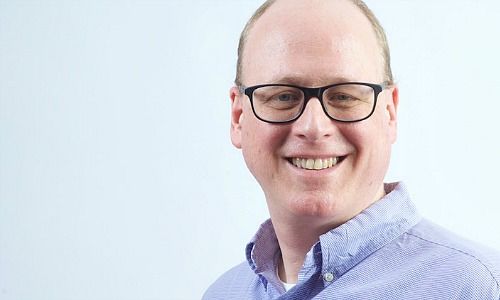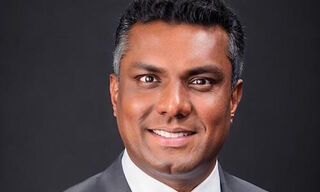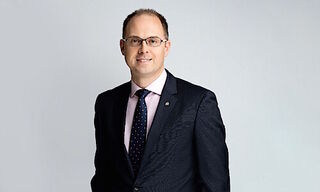It has now emerged that Google’s engineers have succeeded in designing a quantum computer which, for the first time ever, has solved a problem a conventional computer is not able to. We could thus be witnessing a new Sputnik moment in IT, Lars Jaeger writes in his essay on finews.first.
This article is published on finews.first, a forum for authors specialized in economic and financial topics.
The quantum computer – a term that to most people seems to be as weirdly bizarre as excitingly futuristic is pushing its way into the sphere of public attention. It combines the technological omnipotence of digital computing with the awe-inspiring complexity and abstraction of the most important physical theory of the 20th century. It promises a new technological revolution that could shape the 21st century just as strongly as the development of digital circuits did with the 20th century.
For a long time, quantum computers were the stuff of science fiction and their construction lay far in the future. But it is well known that the future is approaching us faster and faster. It has now emerged that Google’s engineers have succeeded in designing a quantum computer which, for the first time ever, has solved a problem a conventional computer is not able to.
«The moment of such ‘quantum supremacy’ seems to have arrived now»
In concrete terms, Google’s computer chip (known as Sycamore) needed just 200 seconds for a special computing task for which the world’s best supercomputer needs 10,000 years. A few years ago Google baptized the concept of a quantum computer being superior to any existing classical computer in the accomplishment of a certain tasks as ‘quantum supremacy’.
The moment of such ‘quantum supremacy’ seems to have arrived now. We could thus be witnessing a Sputnik moment in information technology. Although this is more of a symbolic milestone, since the problem solved by Sycamore is of a very academic nature, Google’s achievement could enormously stimulate the development of quantum information technology, similar to what the historic Sputnik moment in the 1950s did for space travel.
«This bizarre property of quantum particles was once the cause of heated discussions»
So what is a quantum computer? First, although conventional computers (with their ever-smaller components) are subject to quantum effects, their principle functionality is entirely based on classical physics. The so-called ‘von Neumann architecture’ all computers today are based on ensures that calculation steps are processed sequentially, ie bit by bit.
The smallest possible information units each take a well-defined state of either 1 or 0. Quantum computers, in contrast, employ the very properties of quantum theory directly and are thus subject to a completely different information theory. The equivalent of the classical bit in quantum computers is the quantum bit or qubit for short. Qubits have some amazing properties: For example, they can assume both states – 0 and 1 – simultaneously, as well as all intermediate values in between, ie ‘half 1’ and ‘half 0’.
«Each quantum bit ‘knows’, so to speak, what the others are currently doing»
This is due to the possibilities of quantum states to exist in so-called ‘superpositions’, the overlapping of classically mutually exclusive states. This bizarre property of quantum particles was once the cause of heated discussions among the fathers of quantum physics, which eventually found their expression in the well-known thought experiment of Schrödinger’s cat.
In addition, various quantum particles can be brought into so-called ‘entangled states’. This is another bizarre property of the quantum world which holds no equivalence in our classical world. It is as if the qubits are coupled to each other with an invisible spring. Through a ‘spooky action at-a-distance’ (a term originally invented by Albert Einstein to convey ironical intention, as he considered entanglement impossible), qubits are all in direct contact with each other. Each quantum bit ‘knows’, so to speak, what the others are currently doing.
«With this power, problems could be solved that are still far too difficult to process even for the supercomputers»
Therefore, with 100 new information carriers, when the performance of a classical computer has just doubled, the increase in the performance of a quantum computer can hardly be quantified any longer. With this enormous power of parallel computing, problems could be solved that are still far too difficult to process even for the ‘supercomputers’ used today in physics, biology, weather research and elsewhere.
Here we highlight five problems, which are beyond the limits of today’s computers, that show the amazing possibilities that could arise with quantum computers:
1. Cryptography:
Today’s common encryption methods are based on the re-factorization of the products of two very large prime numbers. From a certain number size on, this task can no longer be solved by a classical computer. In 1994, the computer scientist Peter Shor developed an algorithm that, with the help of a quantum computer, could factorize the largest products of prime numbers used today into their divisors within minutes.
2. Solving Complex Optimization Problems:
The task of finding the optimal solution from many variants is considered particularly tricky by mathematicians. Such problems occur in industrial logistics, in the design of microchips or in the optimization of traffic flow. Even with a small number of variations classical computers fail in the calculation of optimal solutions. Quantum computers, on the other hand, could solve such optimization problems in a comparatively short time.
3. Significant Applications Could Also Arise In the Field of Artificial Intelligence:
The ‘deep neural networks’ used therein come with hard combinatorial optimization problems, which can be solved much faster and better by quantum computers than by classical computers. This could make machines smarter by multiples than they are today.
4. Large Databases Searches:
Searching through unsorted data sets, a classical computer has to examine each data point individually. The search time, therefore, increases linearly with the number of data points given and for large amounts of data can become too time-consuming for a classical computer. In 1996, the computer scientist Lov Grover published a quantum computer algorithm for which the number of necessary calculation steps increases only with the square root of the number of data points. Instead of needing a thousand times longer for one billion data entries compared to one million, with the Grove algorithm it would take a quantum computer only a little over 30 times longer – which would be a breathtaking improvement for large numbers.
5. Finding New Chemical Compounds:
In the simulation of quantum systems complex optimization problems occur again and again, where the aim is to find the best possible, ie most energy-efficient, configuration of the electrons in an atom or molecule from many alternatives. Theoretical physicists and chemists have been dealing with such problems for decades with limited success.
«Some physicists even believe quantum computers will enable us to calculate any problems occurring in nature»
The corresponding quantum equations are simply too complex to solve for classical computers. Quantum computers could directly map and model the behavior of the electrons involved since they behave like a quantum system themselves. The better understanding of molecular behavior, and of the detailed chemical reactions, could be used to find new drugs or develop much more efficient battery technologies.
Some physicists even believe quantum computers will enable us to calculate any problems occurring in nature, from the behavior of black holes, the development of the very early universe, the collisions of high-energy elementary particles to the superconductivity and the modeling of the 100 billion of neurons (and the one thousand plus connections in our brain). In any case, it will be worth reading the science section of the daily newspapers more carefully in the coming weeks and months to see what is uncovered.
Lars Jaeger is a Swiss-German author and investment manager. He writes on the history and philosophy of science and technology and has in the past been an author on hedge funds, quantitative investing, and risk management. He is the founder and CEO of Alternative Beta Partners and currently serves asset manager GAM as Head of Alternative Risk Premia.
Previous contributions: Rudi Bogni, Peter Kurer, Oliver Berger, Rolf Banz, Dieter Ruloff, Werner Vogt, Walter Wittmann, Alfred Mettler, Peter Hody, Robert Holzach, Craig Murray, David Zollinger, Arthur Bolliger, Beat Kappeler, Chris Rowe, Stefan Gerlach, Marc Lussy, Nuno Fernandes, Richard Egger, Maurice Pedergnana, Marco Bargel, Steve Hanke, Urs Schoettli, Ursula Finsterwald, Stefan Kreuzkamp, Oliver Bussmann, Michael Benz, Peter Hody, Albert Steck, Martin Dahinden, Thomas Fedier, Alfred Mettler, Brigitte Strebel, Peter Hody, Mirjam Staub-Bisang, Nicolas Roth, Thorsten Polleit, Kim Iskyan, Stephen Dover, Denise Kenyon-Rouvinez, Christian Dreyer, Kinan Khadam-Al-Jame, Robert Hemmi, Anton Affentranger, Yves Mirabaud, Katharina Bart, Frédéric Papp, Hans-Martin Kraus, Gerard Guerdat, Mario Bassi, Stephen Thariyan, Dan Steinbock, Rino Borini, Bert Flossbach, Michael Hasenstab, Guido Schilling, Werner E. Rutsch, Dorte Bech Vizard, Adriano B. Lucatelli, Katharina Bart, Maya Bhandari, Jean Tirole, Hans Jakob Roth, Marco Martinelli, Thomas Sutter, Tom King, Werner Peyer, Thomas Kupfer, Peter Kurer, Arturo Bris, Frederic Papp, James Syme, Dennis Larsen, Bernd Kramer, Ralph Ebert, Marionna Wegenstein, Armin Jans, Nicolas Roth, Hans Ulrich Jost, Patrick Hunger, Fabrizio Quirighetti, Claire Shaw, Peter Fanconi, Alex Wolf, Dan Steinbock, Patrick Scheurle, Sandro Occhilupo, Will Ballard, Michael Bornhaeusser, Nicholas Yeo, Claude-Alain Margelisch, Jean-François Hirschel, Jens Pongratz, Samuel Gerber, Philipp Weckherlin, Anne Richards, Antoni Trenchev, Benoit Barbereau, Pascal R. Bersier, Shaul Lifshitz, Klaus Breiner, Ana Botín, Martin Gilbert, Jesper Koll, Ingo Rauser, Carlo Capaul, Claude Baumann, Markus Winkler, Konrad Hummler, Thomas Steinemann, Christina Boeck, Guillaume Compeyron, Miro Zivkovic, Alexander F. Wagner, Eric Heymann, Christoph Sax, Felix Brem, Jochen Moebert, Jacques-Aurélien Marcireau, Peter Hody, Ursula Finsterwald, Claudia Kraaz, Michel Longhini, Stefan Blum, Zsolt Kohalmi, Karin M. Klossek, Nicolas Ramelet, Søren Bjønness, Lamara von Albertini, Andreas Britt, Gilles Prince, Fabrizio Pagani, Darren Willams, Salman Ahmed, Stephane Monier, and Peter van der Welle, Swetha Ramachandran, Beat Wittmann, Ken Orchard, Michael Welti, Christian Gast, Didier Saint-Georges, Jeffrey Bohn, Juergen Braunstein, Jeff Voegeli, Gérard Piasko, Fiona Frick, Jean Keller, Teodoro Cocca, and Stefan Schneider.





















